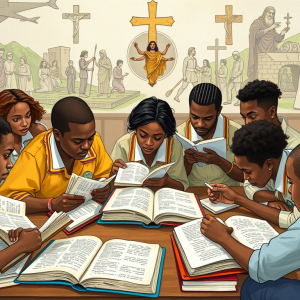Description
Summary of “The Samaritan Guide”
“The Samaritan Guide” is a detailed analysis of a play titled The Samaritan, which explores themes of corruption, technology, governance, and social justice through its characters and plot. The document is structured into acts and scenes, each dissecting the narrative, thematic concerns, stylistic devices, and character portrayals.
Key Themes:
- Corruption and Bad Governance: The play critiques leaders like Mayor Mossi, who misuse power, engage in bribery, and suppress dissent, exemplified by their opposition to the Samaritan app, which exposes their misdeeds.
- Technology and Media: The Samaritan app, created by students Alvita and Montano, becomes a tool for transparency, revealing municipal corruption. The media amplifies these revelations, highlighting its role in accountability.
- Hope vs. Despair: Contrasts a dystopian future (environmental degradation, crime) with optimism fueled by technology and youth innovation.
- Environmental Degradation: The play addresses climate change, pollution, and unsustainable practices, often linked to negligent leadership.
- Justice and Resistance: Characters like Nicole, the ethics teacher, embody resilience against oppression, while others, like Judge Jaden, symbolize systemic corruption.
Plot Overview:
- Act 1: The Samaritan app wins a national innovation award but is rejected by Mayor Mossi, who fears exposure. Municipal leaders conspire to suppress it.
- Act 2: Nicole mentors the students, defending the app’s purpose despite intimidation. Mossi attempts to bribe and threaten her, revealing deeper corruption.
- Act 3: Nicole is arrested, and leaders scheme to discredit the app. Judge Jaden is blackmailed into aiding Mossi’s corrupt agenda.
- Act 4: Leaders feign reconciliation with Nicole, but their hypocrisy is exposed when anti-corruption police arrest them. The play ends on a note of cautious hope.
Stylistic Devices:
- Satire and Irony: Critiques leaders who claim to serve the public while looting resources.
- Biblical Allusions: References like the “Good Samaritan” parable underscore moral lessons.
- Vivid Imagery: Descriptions of settings (e.g., Sagrada School, Maracas Municipality) enhance the narrative’s realism.
Character Highlights:
- Nicole: A courageous teacher who mentors the students and resists corruption.
- Mayor Mossi: A tyrannical leader who embodies greed and impunity.
- Alvita and Montano: Innovative students whose app challenges the status quo.
- Judge Jaden: A corrupt official torn between justice and self-preservation.
Conclusion:
The play is a critique of systemic corruption and a call for accountability, emphasizing youth activism and ethical leadership. Its blend of futuristic technology and biblical motifs creates a compelling narrative about societal change. The document serves as a comprehensive guide, analyzing each scene’s themes, language, and character dynamics.




Reviews
There are no reviews yet.